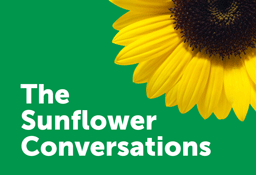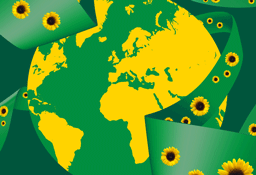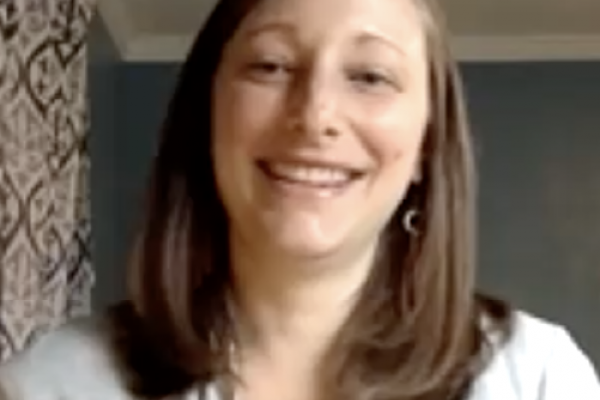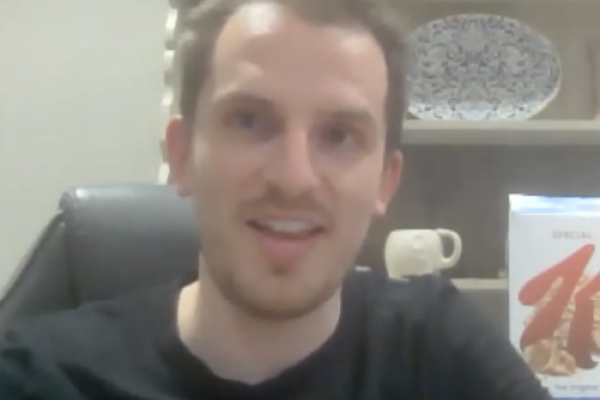Marc Powell, RNIB talks about NaviLens and Kellogg's
If you have a visual impairment how do you know what you are buying, whether it is suitable for your needs, does it contain nuts or other allergens? These are only some of the questions that are never answered for blind and partially sighted people.
NaviLens technology is changing the landscape of communication and giving people with visual impairments equity to be able to make informed decisions on their purchases.
Marc explains how the technology works with the simple use of an app and a smart phone. We also hear about future aspirations beyond Kellogg's and UK, so that the 2 million people in the UK and the 20 million people in Europe with visual impairments can navigate, shop and cook with confidence.
For more information about NaviLens,click here and to explore more about RNIB, click here.
Hosted by Chantal Boyle, Hidden Disabilities Sunflower
Transcript
Chantal Boyle:
Hi. I'm Chantal and joining me today is Marc Powell from the RNIB. Thank you for joining me, Marc. Can you start off by telling us about what your role is at the RNIB?
Marc Powell:
I'm the Strategic Accessibility Leader at RNIB so my role is to effectively raise the bar when it comes to accessibility. I work with major organizations to effectively disrupt and create catalysts for change and address some of the real life challenges that we all have within the accessibility world. You have to delve into an area, disrupt it, showcase the issue or the problem and work with like-minded organizations who want to effectively disrupt that space too to create a more wider-scale, long lasting social change. So I like to call some of the partners or relationships we have as disruptors and [inaudible 00:01:00], because they help us to prove the art of the possible, really.
Chantal Boyle:
Well, can you tell us then about NaviLens? What is it and how have you and the RNIB been involved in it?
Marc Powell:
Yeah. So NaviLens is a technology that we identified about two years ago now, which is effectively the next generation of QR code. NaviLens is very different. It's actually a colourful QR code, which I'll use on the example that we can talk about shortly, but it's a colourful QR code, which looks like this. It's approximately the size of a stamp in the corner and they can come in a range of different sizes. So for example, I've got a NaviLens code which is the size of the one that I've just shown on a Kellogg's box, which is about the size of a stamp. That can be detected from about three meters away, where a NaviLens code the size of an A4 sheet of paper can actually be detected from about 25 to 30 meters away.
Marc Powell:
That's done through the smartphone camera that you have. So, you can you download the NaviLens app and whatever's in that code, we can be talking about product information or navigation information, is relayed to you. So whatever the phone can see is relayed to you. This technology simulates some of those human behaviours that our sighted counterparts have in positional understanding and navigating around the space. Whatever your phone can see is relayed to you and that can be relayed in audio or within text format. That can then be working with your standard accessibility features built into your smartphone. So, it's been used across the world for navigation. So it's in the Barcelona Metro system, for example, on the underground.
Marc Powell:
It's in L.A. and was actually featured in some of the photos from the Oscars and I was in L.A. two years ago and installing it, which was a brilliant experience, and is actually now being featured in a number of places in the world. One of the examples of that where we've implemented it on packaging... So, the reason why we wanted to work with packaging, for example, is... Well, it's for a number of reasons but also, we know that the retail space is another area that NaviLens can be used for. So it's important for in our thinking that we think about solutions that can create that end to end customer journey.
Chantal Boyle:
How does it work practically? Because if you've got lots of different Kellogg's cereal boxes, because that's the first brand that you've worked with in food and beverage, isn't it?
Marc Powell:
I can actually demonstrate it. Now I've got my smartphone-
Marc’s smartphone:
[inaudible 00:04:03].
Marc Powell:
... in my hand and I've activated the NaviLens app. Now what you can do... You're always in control when using NaviLens. If you are pointing in the general direction of the code, I get a click. So I've received two clicks and it will let me know the closest product to me and it told me that Special K was the closest to me. Now, if I'm in an area, like you say, where there's multiple products, then how do I filter that information? What is it I'm looking for? So I could be browsing in which it's going to tell me what's close to me, what's the next closest, but then I can actually select which product I want to look for or filter the information to say, "Actually, I'm only looking for Special K," so it will ignore every other tag and just tell me where Special K is.
Chantal Boyle:
So do you envisage that people would do their shopping list as such before they left the house?
Marc Powell:
There's two ways, really, two different customer journeys here. So if we think of browsing and going around the retail store, you're navigating around the store and then you find a product and then you'll want to know what that product is and you also may want to know, which is incredibly important, what the ingredients are. So that's what we did here with Kellogg's. So if I point my phone in the direction of the box, I get all the information about that on my phone.
Marc’s smartphone:
[inaudible 00:05:36].
Marc Powell:
That's incredibly important for me to get that information in an accessible format because it's not on products. Now I can go into a store and purchase it and be navigated to the product. But also, if I shop online and I get a product, I might want to know how to cook it when I get it home and this information is on there for a reason. It's incredibly important and in a lot of cases, it's quite small anyway. This information, when we did our trials last year, we had people who didn't have a visual impairment saying to us, "Well, this is just easier for me," but when you've got that shopping home, you'll still going to be able to use the NaviLens code to really understand the packaging for cooking instructions or if you've got a squirty spray, for example, for cleaning, "How do I use it? Do I need to wear gloves? Is this toxic?" and this is all the information that we miss out on.
Chantal Boyle:
So do you envisage that this is going to be going beyond cereal packing? Do you see that we'll be able to enter a supermarket grocery store and do your week's shopping using NaviLens technology?
Marc Powell:
I think the dream there, Chantal, that we can really raise the bar in this space and get to a point where we can do that. I'd love to see this on other products and there are a number of organizations who are speaking to us about this right now, following the work we did last year and the announcement by Kellogg's. But this is about providing equal access to information. The fact that it can be detected from a distance is a big bonus as well.
Chantal Boyle:
Are Kellogg's doing it in just in the U.K. or are they doing it on any of their other countries where they operate?
Marc Powell:
Kellogg's have announced that this will be on their cereal portfolio across Europe so this is the first step they've taken. So two million people in the U.K. with sight loss that this could potentially support or 20 million in Europe. So, the amazing thing is here, Chantal, is that we're talking about a solution here that actually, if I go into another country where a Kellogg's product is, if I detect the code, it will automatically translate that information to the native language of my smart device so we're talking about an inclusive solution across the board here. So even just from a language perspective, we are translating information into somebody's native language using the technology we have at our disposal. Ultimately, what we are doing here is we are opening up greater choice and independence, the ability to decide that I want to buy this and therefore, when I buy this, I'm not going to send it back or leave it in the cupboard.
Marc Powell:
It gives people a choice and the ability to independently access information that historically, RNIB tried to crack this space in 2010 and we couldn't because technology just wasn't where it's at now. But now we have technology that's allowing people like me and others to bridge the gap. I think more excitingly, Chantal, that we've actually demonstrated that this can be put on products but actually if we work backwards in the customer journey, when we look at retail, the same solution, being a slightly bigger size code lineage within a retail space, could actually be used to navigate customers around a retail store. That is something that we are really, really focusing on right now because entering a store and getting that end to end customer journey, whether you are blind or partially sighted, or whether you've gone to a supermarket that you've never gone into before.
Chantal Boyle:
Being blind, partially sighted, that's very disabling not knowing where you're going. It would put you off even trying to make that journey so it's really, really exciting. I know that you were thinking about this a few years ago, but now the technology's where it needs to be, so it's really good.
Marc Powell:
NaviLens are a really forward thinking organisation. They are always innovating on their functionality to make it even better for the user.
Chantal Boyle:
What other sectors do you see adopting the NaviLens technology if we look into the future?
Marc Powell:
We are working on and there will be launching in the next couple of weeks examples of NaviLens within travel and transport here in the UK. So not just across the world in the likes of Barcelona, but actually here in the U.K., which we'll be sharing. I was using NaviLens when I went to Spain in a museum and for the first time in my life, I was able to navigate completely independently at my leisure and decide to look at what I wanted to look at for the very first time, to the point where my colleague who was with me, who's actually been within this sector for around 15 years, was actually quite teary because he'd never seen somebody completely just go off independently with a visual impairment and I was showing him around for the first time.
Chantal Boyle:
Well, I wish you all the best with it and we want to follow you guys on the journey and share that with all the Sunflower community as well, of which I know that they will be so excited about what's coming down the line. So thanks for your time today.
Speaker 3:
If you would like to share your Sunflower story or conversation with us email [email protected]. Find out more about us or listen to this recording again by checking out our insights page at hiddendisabilitiestore.com. You can also find us on Facebook, Instagram, Twitter, YouTube and LinkedIn. Please help, have patience and show kindness to others and join us again soon. Making the invisible, visible with the Hidden Disabilities Sunflower.







